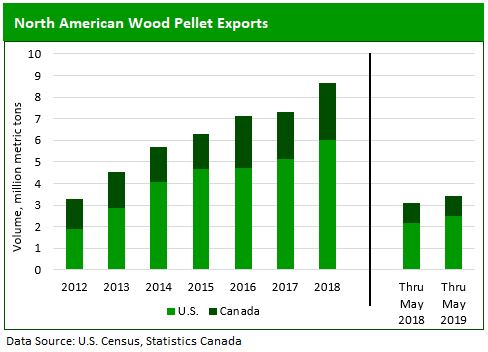This is the fifth in a series related to the Q3 2019 Forisk Research Quarterly.
Through May 2019, North American wood pellet exports increased 11% year-over-year, reaching 3.4 million metric tons.
U.S. wood pellet exports increased 15%. The UK remained the largest importer of U.S. wood pellets through May 2019. The 1.92 million metric tons imported, representing 77% of total U.S. volumes, was a 15% year-over-year increase. Export volumes to Denmark, the second largest importer of U.S. wood pellets in 2019 with 8.0% market share, declined 16% year-over-year. Belgium was the third largest importer of U.S. wood pellets with slightly less than 8.0% market share in 2019, up 11% over this period last year.
Canadian wood pellet exports rose 1.0% year-over-year through May 2019. The growth in 2019 has been driven by the UK and Denmark, which offset year-over-year declines to Asian markets. As with the U.S., the UK remains the largest importer of Canadian wood pellets with 63% of the market share. Exports to the UK gained 1.3% through May 2019, while volumes to Japan declined 2.2% year-over-year.

The two largest pellet producers in North America–Enviva and Pinnacle–have off-take contracts to Asia that will total more than 3.3 million metric tons per year by 2023.
Enviva, the world’s largest producer of wood pellets, has announced off-take contract volumes to Japanese counterparties that are expected to approach two million metric tons per year by 2023. Pinnacle, the world’s third largest producer of pellets and Canada’s largest, has off-take volumes to Asia that are expected to surpass 1.3 million metric tons annually by 2022. Pinnacle’s 315 thousand metric tons per year off-take with CGN, which begins in 2021, looks to solidify South Korea as a major end-market for Canadian wood pellets. The off-take represents the first long-term contract into South Korea’s market. Pinnacle has since added an additional contract with CGN and GS Global. Previously, the country depended on open-market tenders to meet demand.

To download the most recent Wood Bioenergy Summary, click here.

Leave a Reply